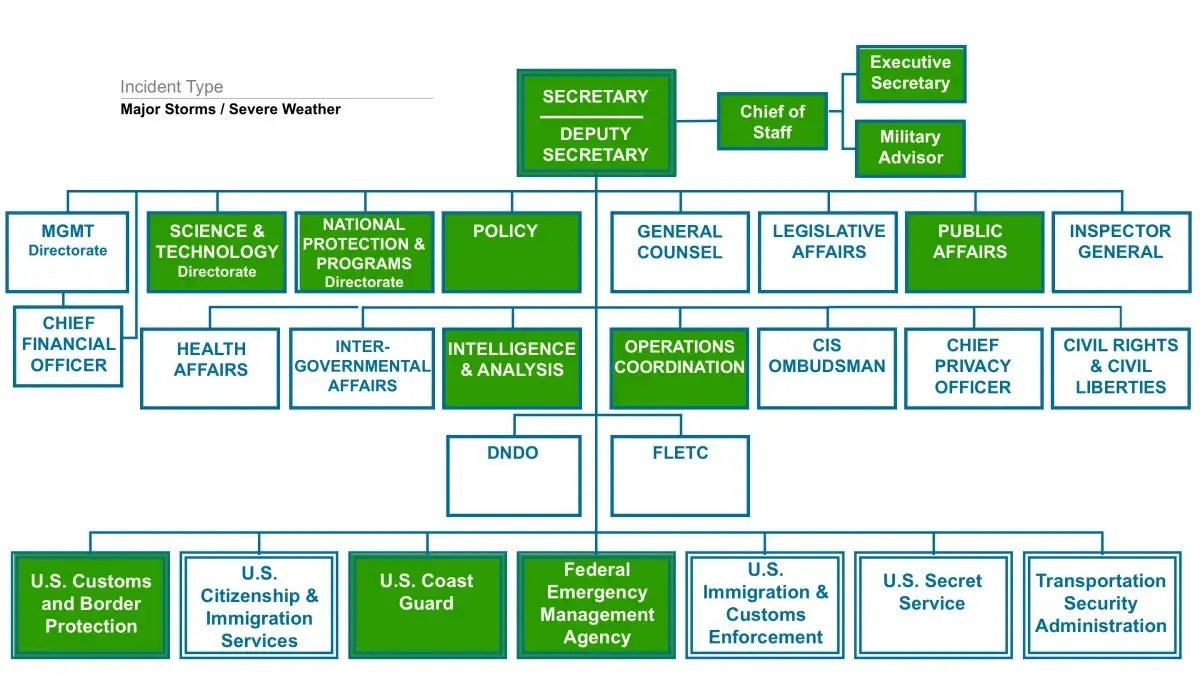Major storms or hurricanes are those impacting the United States resulting in direct economic loses of greater than $100 million. Here's what DHS does to respond natural threats and help communities recover.

Download "Incident Type: Major Storms / Severe Weather" (848KB JPG)
Secretary
- Reaches out to governors of affected states and mayors of cities in the storm’s path to make sure the governors’ and mayors’ teams have the support they need to prepare for the storm’s arrival.
- Responsible for recommending to the President of the United States that authorization be given to allow Federal resources to be deployed to assist State and local jurisdictions whose resources or capacity for effective response is overwhelmed.
- Ensures that, as appropriate, incident information is prepared and disseminated to the public.
Mil Advisor
- Serves as the focal point for DHS-DoD collaboration for homeland defense and incident management.
- Synchronizes and coordinates with DoD operations through overseeing Military Assistants to the Secretary and Deputy Secretary of Homeland Security.
- As the senior U.S. Coast Guard (USCG) officer resident at DHS headquarters, facilitates action involving USCG.
Office of Public Affairs
- If the Emergency Support Function (ESF) for External Affairs is activated, the National Joint Information Center (NJIC) will coordinate with and supports the White House, Secretary of Homeland Security, the National Operations Center (NOC) Crisis Action Team, and the National Response Coordination Center to coordinate the Federal communications response.
Office of Operations Coordination
- The National Operations Center (NOC) monitors the storm and its effects, fusing this information into a Common Operating Picture (COP) and relaying this to the NRCC and other Federal, State and local government partners.
Office of Intelligence & Analysis
- Consolidates requests for information at the national-level and tracks response deadlines through the Homeland Security Information Network (HSIN).
National Protection and Programs Directorate
- Provides Infrastructure Impact Assessments and other analytical tools to the Secretary of Homeland Security.
Office of Policy
- Provides timely advice and analysis to the Secretary and other Departmental decision-makers.
Science and Technology Directorate
- May deploy technologies developed by DHS in conjunction with the academic community and private sector community that may be of use to first responders as the incident necessitates.
United States Customs and Border Protection (CBP)
- May move officers from around the country into the affected region to assist with recovery efforts.
- These efforts include ensuring air and sea ports in the affected area are fully staffed and ready to receive passengers and cargo as they return to operation.
- Works to expedite the arrival of power recovery crews arriving from other neighboring nations if needed.
- Increases capacity to conduct cargo container inspections in order to facilitate the flow of goods into affected areas.
Federal Emergency Management Agency (FEMA)
- The FEMA Administrator activates the National Response Coordination Center (NRCC), FEMA’s facility for coordinating all disaster relief efforts and providing assistance for required emergency measures to save lives and protect property, public health and safety.
- Works closely with state and local partners to identify and address needs of affected communities. Sends resources and FEMA Corps response teams into affected areas.
- Deploys POD sites, centralized points where supplies are delivered and to where the public travels to pick up commodities following a disaster or emergency.
- Depending on the severity of damage caused on land, may leverage its network of Search and Rescue teams to affected areas.
- Assists affected communities in finding temporary housing and getting grants to assist with necessary repairs, among other types of aid.
- Opens Disaster Recover Centers in the hardest hit areas, where affected citizens met with officials and apply for disaster assistance.
United States Coast Guard (USCG)
- Conducts search and rescue operations for those caught in severe weather on the high seas.
- Places teams along impacted areas to conduct search and rescue missions, respond to and mitigate threats to public health and the environment.
- Asses and advises on the status of ports along the affected region.
- Takes a leading role in responding to pollutants put into the environment due to severe weather compromising pollutant containment facilities.
Energy Department
- May distribute fuel from its Heating Oil Reserve to assist those affected.
Department of Defense
- The Defense Logistics Agency may purchase fuel to distribute to affected areas.
- At the direction of FEMA, the U.S. Army Corps of Engineers supports de-watering efforts, as well as deploying temporary emergency power assets.
- If affected region is coastal, U.S. Navy may deploy asses to assist in rescue operations and provide landing platforms for Coast Guard helicopters as needed.
U.S. Department of Health and Human Services
- May deploy personnel to provide health and medical assistance to those affected.
